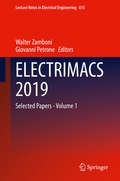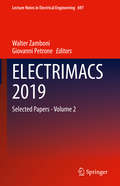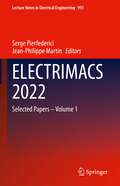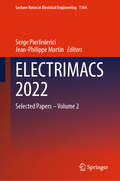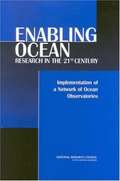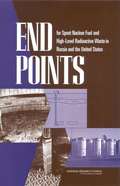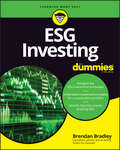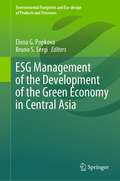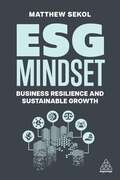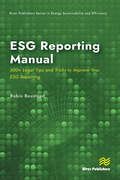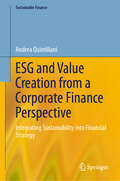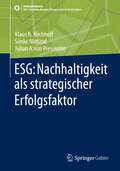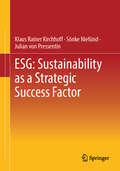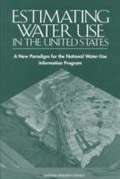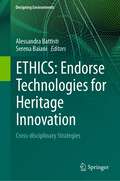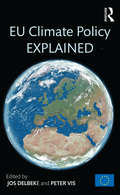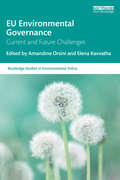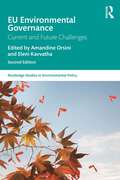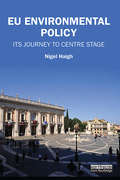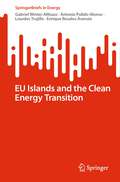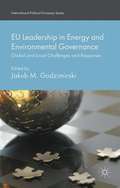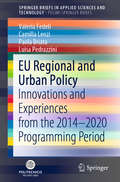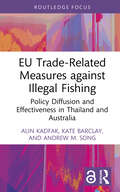- Table View
- List View
EDC Earth Science
by Ruth KrumhanslOur home planet is an incredible and largely unexplored place. Less is known about Earth's surface than about the surface of the Moon, or Mars. As you work your way through the chapters of this course, you'll learn things that are well understood by scientists and you'll also encounter uncertainties. You'll be challenged to support your answers with evidence, and encouraged to debate them with your classmates. At the end of this course, you should feel like you've learned many things.
ELECTRIMACS 2019: Selected Papers - Volume 1 (Lecture Notes in Electrical Engineering #604)
by Giovanni Petrone Walter ZamboniThis book collects a selection of papers presented at ELECTRIMACS 2019, the 13th international conference of the IMACS TC1 Committee, held in Salerno, Italy, on 21st-23rd May 2019. The conference papers deal with modelling, simulation, analysis, control, power management, design optimization, identification and diagnostics in electrical power engineering. The main application fields include electric machines and electromagnetic devices, power electronics, transportation systems, smart grids, electric and hybrid vehicles, renewable energy systems, energy storage, batteries, supercapacitors and fuel cells, and wireless power transfer. The contributions included in Volume 1 are particularly focused on electrical engineering simulation aspects and innovative applications.
ELECTRIMACS 2019: Selected Papers - Volume 2 (Lecture Notes in Electrical Engineering #697)
by Giovanni Petrone Walter ZamboniThis book collects a selection of papers presented at ELECTRIMACS 2019 - The 13th international conference of the IMACS TC1 Committee, held in Salerno, Italy, on 21st-23rd May 2019. The conference papers deal with modelling, simulation, analysis, control, power management, design optimization, identification and diagnostics in electrical power engineering. The main application fields include electric machines and electromagnetic devices, power electronics, transportation systems, smart grids, electric and hybrid vehicles, renewable energy systems, energy storage, batteries, supercapacitors and fuel cells, wireless power transfer. The contributions included in Volume 2 are particularly focussed on methodological aspects, modelling and applied mathematics in the field of electrical engineering.
ELECTRIMACS 2022: Selected Papers – Volume 1 (Lecture Notes in Electrical Engineering #993)
by Serge Pierfederici Jean-Philippe MartinThis book collects a selection of papers presented at ELECTRIMACS 2021, the 14th international conference of the IMACS TC1 Committee, held in Nancy, France, on 16th-19th May 2022. The conference papers deal with modelling, simulation, analysis, control, power management, design optimization, identification and diagnostics in electrical power engineering. The main application fields include electric machines and electromagnetic devices, power electronics, transportation systems, smart grids, renewable energy systems, energy storage like batteries and supercapacitors, fuel cells, and wireless power transfer. The contributions included in Volume 1 will be particularly focused on electrical engineering simulation aspects and innovative applications.
ELECTRIMACS 2022: Selected Papers – Volume 2 (Lecture Notes in Electrical Engineering #1164)
by Serge Pierfederici Jean-Philippe MartinThis book collects a selection of papers presented at ELECTRIMACS, 2022 the14th international conference of the IMACS TC1 Committee, held in Nancy, France, on 17st-21rd May 2022. The conference papers deal with modelling, simulation, analysis, control, power management, design optimization, identification and diagnostics in electrical power engineering. The main application fields include electric machines and electromagnetic devices, power electronics, transportation systems, smart grids, electric and hybrid vehicles, renewable energy systems, energy storage, batteries, supercapacitors and fuel cells, and wireless power transfer. The contributions included in Volume 2 are particularly focused on methodological aspects, modelling, and applied mathematics in the field of electrical engineering.
ENABLING OCEAN RESEARCH IN THE 21ST CENTURY: Implementation of a Network of Ocean Observatories
by Committee on the Implementation of a Seafloor Observatory Network for Oceanographic ResearchAs the importance of the oceans to society grows, so does the need to understand their variation on many temporal and spatial scales. This need to understand ocean change is compelling scientists to move beyond traditional expeditionary modes of investigation. Observing systems will enable the study of processes in the ocean basins over varying timescales and spatial scales, providing the scientific basis for addressing important societal concerns such as climate change, natural hazards, and the health and viability of living and non-living resources along our coasts and in the open ocean. The book evaluates the scientific and technical readiness to move ahead with the establishment of a research-driven ocean observatory network, and highlights outstanding issues. These issues include the status of planning and development, factors that affect the timing of construction and installation, the cost and requirements for maintenance and operations, needs for sensor development and data management, the impact on availability of ships and deep submergence facilities, and the role of research-based observatories within national and international operational ocean observing systems being developed and implemented.
END POINTS for Spent Nuclear Fuel and High-Level Radioactive Waste in Russia and the United States
by Committee on End Points for Spent Nuclear Fuel High-Level Radioactive Waste in Russia the United StatesEnd Points for spent Nuclear Fuel and High-Level Radioactive Waste in Russian and the United Statesprovides an analysis of the management of spent nuclear fuel and high-level radioactive waste in Russia and the United States, describing inventories, comparing approaches, and assessing the end-point options for storage and disposal of materials and wastes. The authoring committee finds that despite differences in philosophy about nuclear fuel cycles, Russia and the United States need similar kinds of facilities and face similar challenges, although in Russia many of the problems are worse and funding is less available. This book contains recommendations for immediate and near-term actions, for example, protecting and stabilizing materials that are security and safety hazards, actions for the longer term, such as developing more interim storage capacity and studying effects of deep injection, and areas for collaboration.
ESG Investing For Dummies
by Brendan BradleyYour guide to investing for a more sustainable world Investing in one’s own future has always been a good financial move. But what if you want to ensure that the companies you have a financial interest in are also helping to improve the present and future of all of us—and of the planet? More than ever before, sustainable investors want to be confident that a company’s Environmental (net zero emissions target), Social (response to the Covid-19 pandemic), and Governance (no repeats of Enron and WorldCom) policies and actions are positively impacting the global outlook—and to identify ways that their dollar can incentivize business leaders to do even better. The worldwide rise of an Environmental, Socially Responsible, and Governance (ESG) approach to investing shows you’re not alone, and the $30+ trillion—and growing—committed in this way says it’s already become a transformative global movement. ESG provides a framework for evaluating companies that, unlike unrelated investment strategies, informs and guides sustainable investment. Even if you’re a novice investor, ESG For Dummies will allow you to hit this new investing landscape running, providing you with measurable ways to factor ESG into company performance, see how these are reflected in your investment return, and show how you can monitor companies to ensure your money is being put to ethical use. You’ll also become familiar with the big names to follow in the ESG world, how they’re already effecting positive change, and how you can help. Identify the drivers for each category of ESG Define and measure material ESG factors for investing success Understand principles for building a diversified sustainable portfolio Recognize material ESG factors effect on company performance ESG investing introduces powerful tools to do real and lasting good: this book shows you how to use them to help make everyone’s future, including your own, much more secure.
ESG Management of the Development of the Green Economy in Central Asia (Environmental Footprints and Eco-design of Products and Processes)
by Elena G. Popkova Bruno S. SergiThis book proposes digitalization as a promising direction for green growth and sustainable development of the economy of Central Asia. It reveals the advanced and unique hands-on and case-based experience of Central Asia in ESG management with the involvement of digital technologies and provides practical recommendations on the extension of the use of digital technologies in ESG management of the development of the green economy in Central Asia.
ESG Mindset: Business Resilience and Sustainable Growth
by Matthew SekolBusinesses who take environmental, social and corporate governance (ESG) seriously can transform their companies, industries and economies worldwide. Learn how to think critically about ESG to ensure your company remains resilient with sustainable growth in the long term. ESG goes beyond decarbonization commitments, corporate goals and industry awards to core business issues, stakeholders and the balance sheet. Managing these risks and opportunities requires courage, imagination and careful analysis to improve and innovate around what is and isn't working at a company. It requires mainstreaming a consistent definition of ESG so key decision-makers are empowered to act across the business and their value chains, including in daily business practices, communication with stakeholders, financial considerations, and the integration of new technologies and products.ESG Mindset guides business leaders, ESG specialists and CSR strategists through the nuanced and most thoughtful ways to focus on these core business issues. Equipping readers with an enhanced way to think through complex business decisions and interconnected crises, the book provides accessible perspectives and real-world examples from companies around the world that have implemented a meaningful approach to ESG and learned lessons along the way. Readers will learn how to think about pressing ESG challenges from a new perspective and build defensibility in their efforts to future-proof a business and potentially save the world as only they can.
ESG Reporting Manual: 500+ Legal Tips and Tricks to Improve Your ESG Reporting (River Publishers Series in Energy Sustainability and Efficiency)
by Robin BousteadAre you struggling to navigate the complex landscape of ESG compliance? Do you fear falling victim to allegations of green or social-washing while also striving to deliver value for your shareholders? Look no further. Our ESG Reporting Manual offers 500+ legal tips and tricks, presented in a practical step-by-step format, to help your organization meet its reporting obligations and achieve success. Written by a seasoned business owner with decades of experience, this manual is your ultimate guide to navigating the complexities of ESG legislation with confidence. Don't let confusion hold you back any longer – let our manual guide you towards compliance and growth.
ESG and Value Creation from a Corporate Finance Perspective: Integrating Sustainability into Financial Strategy (Sustainable Finance)
by Andrea QuintilianiThis book offers a rigorous examination of ESG (Environmental, Social, and Governance) integration within corporate finance, bridging key gaps in existing academic research. The author reframes ESG not as a peripheral concern, but as a strategic imperative in contemporary corporate value creation. Drawing on recent theoretical advances and empirical findings, it analyses how ESG factors influence capital costs, financial performance, risk management, and long-term competitiveness for companies. The book is an essential reading for researchers and finance scholars wanting to deepen their knowledge on the topic.
ESG: Nachhaltigkeit als strategischer Erfolgsfaktor (SDG - Forschung, Konzepte, Lösungsansätze zur Nachhaltigkeit)
by Klaus Rainer Kirchhoff Sönke Niefünd Julian A. von PressentinImmer mehr Investoren haben ESG-Kriterien in ihre Investitionskriterien integriert und immer mehr Banken ergänzen ihre Vergaberichtlinien für Kredite um ESG-Aspekte. Mit einer gelebten ESG-Strategie und ESG-Kommunikation werden Unternehmen für Investoren und Banken folgerichtig attraktiver.Dieses Buch soll Unternehmern und Managern zeigen, wie sie zu einer überzeugenden ESG-Strategie kommen und wie sie diese professionell kommunizieren.
ESG: Sustainability as a Strategic Success Factor
by Klaus Rainer Kirchhoff Sönke Niefünd Julian von PressentinMore and more investors have integrated ESG criteria into their investment criteria, and an increasing number of banks are supplementing their lending guidelines with ESG aspects. With a lived ESG strategy and ESG communication, companies consequently become more attractive to investors and banks. This book aims to show entrepreneurs and managers how to develop a convincing ESG strategy and how to communicate it professionally.
ESTIMATING WATER USE IN THE UNITED STATES: A New Paradigm for the National Water-Use Information Program
by Committee On Usgs Water Resources ResearchThe U. S. Geological Survey's National Water-Use Information Program is principally concerned with quantifying the country's use of water through the synthesis of county-level data for five-year periods. This National Research Council report, produced at the request of the Geological Survey, offers consensus recommendations on how to improve the currently varied quality of data collection across the states. Among the recommendations of the report are suggestions that the Program should be elevated to a water use science program with dedicated funding from Congress; for the systematic integration of datasets; and for the integration of water use, water flow, and water quality information. Annotation ©2004 Book News, Inc. , Portland, OR (booknews. com)
ETHICS: Cross-disciplinary Strategies (Designing Environments)
by Alessandra Battisti Serena BaianiThis book outlines, within the Italian national framework, the current and potential paths oriented towards a new concept of Architectural Heritage, through actions referring to Innovation and Experimentation and Protection and Transformation of the Architectural Heritage. The development of the themes is articulated in two sessions dealing with the aspects related to the analysis and mapping of Architectural Heritage to face the context of the current Climate Crisis and the development of projects and experimentations oriented to the Green and Digital Transition. The evolution of the concept of Heritage, as conceived by the United Nations 2030 Agenda and in the Green Deal and New European Bauhaus, aimed at constructing an inclusive and universally recognised definition to support supranational objectives of sustainable human development, gives rise to innovative strategies, methodologies and technologies that—in a direction of mitigation, contrast and adaptation to climate change—allow for the safeguard, renewed management and a hope for valorisation of Heritage on a national scale. In this direction, the understanding of Architectural Heritage as a 'non-renewable resource' determines the need to activate design experimentation laboratories oriented towards regeneration, articulated and complex, which require, in order to respond to the challenges posed by our era, a sensitive and dialogic multidisciplinary vision of a holistic type. In fact, on the one hand, it is necessary to redefine the usability and management methods of built heritage through the adoption of digital, mobility, energy, ecological, social, green and blue infrastructures; on the other hand, it is necessary to introduce new qualitative and quantitative parameters and performance indicators, adequate to verify the validity of the implemented strategies in a perspective of adaptation to climate change, able to clarify contents, processes and tools to contrast future risks. The pursuit of these objectives refers to the innovation of training paths, professionalising procedures, administrative regulations, and public policies that involve citizens and the private partnership towards a different project qualification and empowerment of stakeholders, inhabitants, professionals, and clients. The Technological Project makes it possible to activate different interventions aimed at acting, in an integrated manner, on assets, context and communities, according to an approach that reinterprets them on a common score, as proposed by the European Next Generation programme in three priority aspects: digitalisation and innovation, environmental transition, increased resilience and social sustainability of national economies. In this scenario, the interventions aimed at outlining sustainable development actions will have to place these concepts at the centre in a harmonious vision that starts from the recognition and enhancement of the Architectural Heritage, recognising it as a fundamental asset of the territories.
EU Climate Policy Explained
by Jos Delbeke Peter VisThe EU has been the region of the world where the most climate policies have been implemented, and where practical policy experimentation in the field of the environment and climate change has been taking place at a rapid pace over the last twenty-five years. This has led to considerable success in reducing pollution, decoupling emissions from economic growth and fostering global technological leadership. <P><P>The objective of the book is to explain the EU's climate policies in an accessible way, to demonstrate the step-by-step approach that has been used to develop these policies, and the ways in which they have been tested and further improved in the light of experience. The book shows that there is no single policy instrument that can bring down greenhouse gas emissions, but the challenge has been to put a jigsaw of policy instruments together that is coherent, delivers emissions reductions, and is cost-effective. The book differs from existing books by the fact it covers the EU's emissions trading system, the energy sector and other economic sectors, including their development in the context of international climate policy. <P><P>Set against the backdrop of the 2015 UN Climate Change conference in Paris, this accessible book will be of great relevance to students, scholars and policy makers alike.
EU Environmental Governance: Current and Future Challenges (Routledge Studies in Environmental Policy)
by Amandine Orsini Elena KavvathaThis book presents an overview of the field of environmental law and policies within the European Union, from theoretical foundations to major issues and applied governance solutions. Drawing on expertise from renowned academics and practitioners from different disciplines, EU Environmental Governance: Current and Future Challenges helps readers to understand the main legal, political and economic issues of environmental protection since the adoption of the Paris Agreement by the European Union in 2015, until the 2020 Brexit, European Green Deal and coronavirus outbreak. The authors examine a broad range of sensitive and topical environmental issues including climate change, air pollution, waste management and circular economy, nuclear waste, biodiversity, agriculture, chemicals, nanotechnology, the environmental impacts of trade and environmental conflicts, presenting both current insights and future challenges. Overall, this volume exposes the reader to a vast array of empirical case studies, which will bolster their training and help tackle the environmental challenges faced by Europe today. This book is a valuable resource for students, researchers and policymakers across a broad range of fields, including environmental law and policies, environmental economics, climate science and environmental sociology.
EU Environmental Governance: Current and Future Challenges (Routledge Studies in Environmental Policy)
by Amandine Orsini Eleni KavvathaThis book presents an overview of the field of environmental law and policies within the European Union (EU) and externally, from theoretical foundations to major issues and applied governance solutions.Drawing on expertise from renowned academics and practitioners from different disciplines, EU Environmental Governance: Current and Future Challenges helps readers to understand the main legal, political and economic issues of environmental protection since the adoption of the European Green Deal in 2019. This new edition presents both current insights and future challenges as they seem to be emerging in the new geopolitical era in the EU after major events such as the COVID‑19 pandemic and the Russian invasion in Ukraine. The authors examine a broad range of sensitive and topical environmental challenges including climate change, air and environmental pollution, waste management, biodiversity protection, environmental and human health, marine biodiversity, renewable energy, nuclear energy and sustainable Arctic governance. Overall, this volume exposes the reader to a vast array of empirical case studies, which will bolster their training and help tackle the environmental challenges faced by Europe today.This book is a valuable resource for students, researchers and policymakers across a broad range of fields, including environmental law and policies, environmental economics, climate science and environmental sociology.
EU Environmental Policy: Its journey to centre stage
by Nigel HaighAt a time when Europeans across the continent are focused on the EU's future direction, this book provides an important contribution to the current debate. Created for reasons quite unconnected with the environment, the EU has been given a compelling new justification by the success of its environmental policy. A number of factors – including a number of threats that came to prominence in the 1980s, and the new concept of 'sustainable development' – are responsible for pushing environmental policy to the forefront of its agenda. Nigel Haigh, a leading authority on the development and implementation of EU environmental policy, traces its evolution from obscurity to centrality. Drawing on a range of articles and lectures, he demonstrates how the EU has not only adapted itself to take on entirely new subject matter, but also has contributed to solving problems which individual Member States could not have dealt with on their own. The book goes on to contextualise the issues throughout its history and offers insight into the future role of the EU in environmental matters. This book is a valuable resource for academics and scholars as well as professionals and policy makers in the areas of environment and sustainability, politics, international relations and European affairs.
EU Islands and the Clean Energy Transition (SpringerBriefs in Energy)
by Enrique Rosales-Asensio Gabriel Winter-Althaus Antonio Pulido-Alonso Lourdes TrujilloThis book explains the challenges and barriers of island energy systems in the European Union. It reviews the research projects carried out to date, and proposes a new feasible scheme that could be advantageous to many isolated energy systems. The book contains a thorough literature review, to ensure the originality of its ideas. It provides a clear insight of the opportunities and difficulties facing EU island energy systems.
EU Leadership in Energy and Environmental Governance: Global And Local Challenges And Responses (International Political Economy Series)
by Jakub M. GodzimirskiThis edited collection focuses on the impact of the changing global distribution of power on the EU's energy policy and ability to project its approach to energy-related issues abroad. It maps the EU's changing position on global energy, the impact of various factors on its energy policy, and its relations with Russia, China, the USA and Brazil.
EU Regional and Urban Policy: Innovations and Experiences from the 2014–2020 Programming Period (SpringerBriefs in Applied Sciences and Technology)
by Valeria Fedeli Camilla Lenzi Paola Briata Luisa PedrazziniThe book critically reflects on some of the most important novelties and experimentations in the context of the European Union’s renewed urban and regional policy in the last programming period, 2014-2020. In particular, it examines four main innovations characterizing this period, which emerged as a result of the deep rethinking and reorganization of Cohesion Policy in the spirit of the place-based approach to local development, i.e. the development of the smart specialization strategy, the establishment of macro-regions, the focus on the urban dimension as a horizontal priority, and the role of social innovation in urban policy. Unlike other similar books, it analyzes the urban dimension of the reformed EU cohesion policy, especially focusing on its interplay with the regional dimension, and which has not been fully addressed to date. The book is intended for social scientists engaged in research on European issues, especially from regional and urban perspectives, policy-makers, particularly at the local level, and graduate students interested in regional and urban European matters.
EU Trade-Related Measures against Illegal Fishing: Policy Diffusion and Effectiveness in Thailand and Australia (Routledge Focus on Environment and Sustainability)
by Kate Barclay Andrew M. Song Alin KadfakFocusing on the experiences of Thailand and Australia, this book examines the impact of trade-restrictive measures as related to the EU’s regulations to prevent Illegal, Unreported and Unregulated (IUU) fishing. It is widely accepted that IUU fishing is harmful, and should be stopped, but there are different approaches to tackling it. Acknowledging this, this book argues that major efforts to fight IUU fishing require careful analyses if the goal is to achieve optimal results and avoid unintended consequences. The book draws on the recent experiences of Thailand and Australia to offer an empirical examination of one increasingly prominent solution, trade-restrictive measures. With Thailand representing direct, active intervention by the EU and Australia a more indirect dispersion of policy narratives and discourses, the book provides a rounded view on how likely it is that different countries in different situations will adapt to the changing policy norms regarding IUU fishing. Understanding the reactions of countries who might be targeted, or otherwise be influenced by the policy, generates new knowledge that helps inform a more effective and scalable implementation of the policy on the part of the EU and a better governance preparedness on the part of non-EU fishing nations. In broader terms, this book exposes a key moment of change in the compatibility between environmental regulations and international trade. The EU IUU policy is a prime example of a policy that uses the mechanisms of international trade to account for environmental and conservation objectives. By way of the unilateral and trade-restrictive stance against IUU fishing, the EU has positioned itself as a major market and normative power, driving its sustainability norms outwards. This book sheds light on the efficacy of this policy setup based on the analysis of country perspectives, which is a key factor influencing its potential spread. This book will be of interest to students and scholars of international fisheries politics, marine conservation, environmental policy and international trade, and will also be of interest to policymakers working in these areas.

